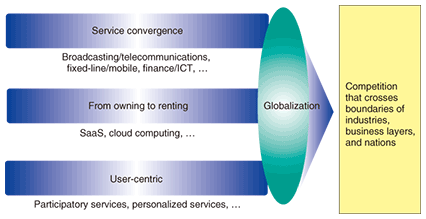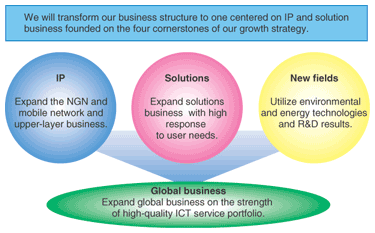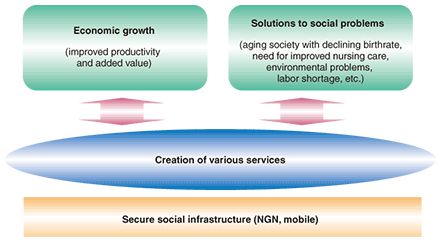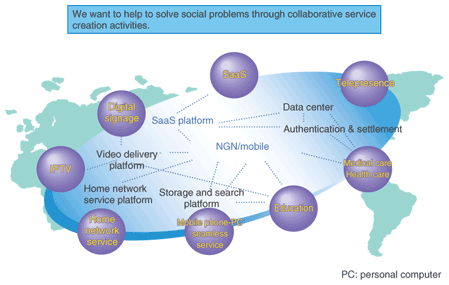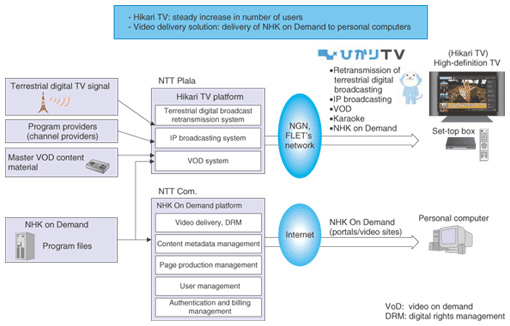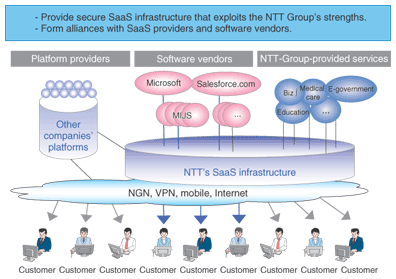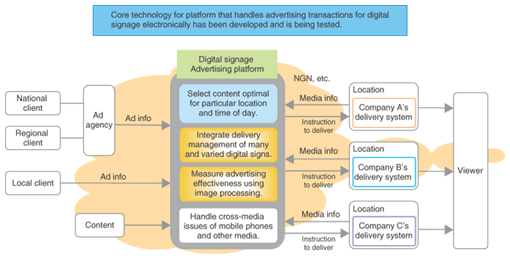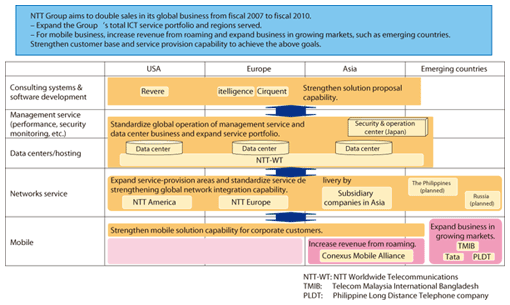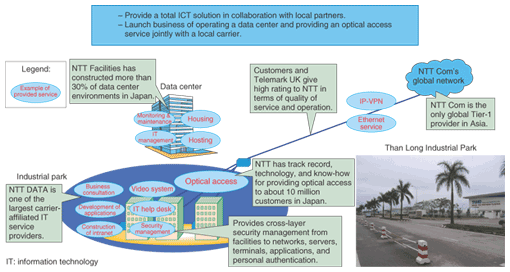 |
|||||||||||
|
|
|||||||||||
|
Special Feature: Keynote Speeches at NTT R&D Forum 2009 Vol. 7, No. 4, pp. 1–12, Apr. 2009. https://doi.org/10.53829/ntr200904sf1 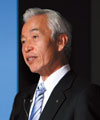 NTT Group’s Activities to Promote Service CreationAbstractThis article discusses NTT’s activities centered on service creation. It is based on the lecture presented by Satoshi Miura, President and CEO of NTT, at the NTT R&D Forum 2009 held on February 19–20, 2009. 1. Current economic crisisThe world economy has been suffering a serious crisis that was touched off by the subprime loan problem. A crisis of this magnitude is often called a once-a-century crisis. This one occurred simultaneously worldwide, causing an abrupt credit crunch and a plunge in real economic wealth. In Japan, on top of these events, the value of the yen has climbed sharply, seriously hurting corporate performance, especially export sales, and leading to job loses. Although the telecommunications industry is considered relatively immune to changes in the economic climate, the NTT Group is experiencing slower growth of sales of optical access services and mobile phones in the consumer market and reduced or postponed investment in information and communications technology (ICT) in the business market. The Group expects to see a seriously adverse business environment for some time. However, we should not be completely pessimistic about the future. Japan experienced two oil shocks in the 1970s, an economic recession caused by appreciation of the yen in the late 1980s, and a prolonged recession after the collapse of the bubble economy: it overcame all of these by drawing on the resourcefulness of its people. Times of crisis can spur changes in thinking and allow ideas for reforming to gain ground, giving rise to innovations that can transform society and industries. Therefore, now is an important time to stockpile resources for future growth. The NTT Group, for its part, is seeking to contribute to economic recovery and future growth by constructing secure networks and creating new services that will exploit them. 2. Dramatic changes in information communicationA number of dramatic changes are taking place in the world of information communication (Fig. 1). One change is service convergence. Convergence between broadcasting and telecommunications and between fixed-line and mobile services is advancing and convergence between personal computers and information appliances, such as TVs, is occurring. Business structures are also undergoing dramatic changes as a result of linkage between ICT and various industries, such as the financial, distribution, and automobile industries.
Another change is a shift from owning information systems to renting them. As a result of the widespread availability of broadband and virtualization technologies, there is an accelerating shift from owning information systems to accessing them via a network, as exemplified by software as a service (SaaS) and cloud computing. Thirdly, services have increasingly become user-centric. Services in which users participate, such as weblogs (blogs) and social networking services (SNSs), have been growing and have begun to exert a significant influence as media. In the USA, YouTube™ and various SNSs were exploited in the presidential election. ersonalized services, such as ones for searching vast amounts of data for information that matches the user’s interest, are expected to develop rapidly. What is more, these changes are taking place globally. They have transformed the nature of competition in the telecommunications industry. While conventional competition has been between carriers, competition these days crosses the traditional boundaries of industries, business layers, and nations, as exemplified by the competition presented by Google and iPhone. 3. NTT’s new medium-term management strategy3.1 Policy for deployment of ubiquitous broadband servicesAgainst the background of the abovementioned profound changes, NTT announced its new medium-term management strategy “Road to Service Creation Business Group” in May 2008. The previous medium-term management strategy, formulated in 2004, centered on fixed-line services, and its two pillars were expansion of optical access and construction of the Next Generation Network (NGN). We now have reasonable prospects for moving towards these targets. By September 2008, the number of subscribers to the optical access services of NTT EAST and NTT WEST exceeded ten million. Our commercial NGN service was launched in March 2008, and it will cover 60% of the current optical access service areas by the end of March 2009. In the field of mobile services, the next-generation service called LTE (Long Term Evolution) will start by 2010. This means that a full-IP network infrastructure will be in place for both fixed-line and mobile services by March 2011 (IP: Internet protocol). The Group’s next mission is allow a wide variety of services to flourish on these full-IP networks. 3.2 Four cornerstones of growth strategyOur growth strategy will be founded on four cornerstones: (1) IP networks and upper-layer business that exploits them, (2) solutions business, (3) business in new fields that utilize environmental and energy technologies resulting from our R&D, and (4) global business that embraces all of the above (Fig. 2). In parallel, we will seek to reduce costs by improving efficiency in both facilities and sales procedures. By pursuing both growth and improved efficiency, we will drastically transform our business structure into one that is centered on IP and solutions businesses.
3.3 Social significance of service creationService creation is not only the key activity for our growth strategy, but also an important one for society (Fig. 3).
First, it will contribute to economic growth. The ICT industry accounted for about 40% of the annual growth of Japan’s real gross domestic product. Moreover, being closely interrelated with all other industries, it has a very large spillover effect on the economy. In particular, amid the current severe economic conditions, we believe that it is important to promote the use of ICT through service creation in order to achieve economic recovery and growth. Second, service creation will help solve social problems. As its population ages and its birthrate declines, Japan is now confronted with wide-ranging social problems, such as the need for improved nursing care, a labor shortage, environmental and energy problems, and the need for better preparedness for natural disasters. We want to help to solve these problems by providing ICT-based services, such as for telemedicine and teleworking. However, even as we shift our focus to services, we will never neglect the infrastructure. The richer services become, the more important the infrastructure that supports them will be. As a carrier, we will continue to do our utmost to provide a secure infrastructure. 3.4 Activities to cope with the dark side of ICTAs ICT continues to make progress, many aspects of its dark side have become apparent. Serious incidents, such as information leakage, virus attacks, websites promoting suicide, and bank transfer scams, are reported every day. Unless these problems are addressed, society cannot ensure economic growth, and we cannot hope for the development of the ICT industry. As a carrier, we are taking these problems seriously and making a focused effort to address them. Recently, there has been intense debate about the pros and cons of allowing children to take mobile phones to school, and there is growing concern about verbal bullying through unsupervised school websites. To cope with these problems, NTT DOCOMO is sending lecturers to schools to hold mobile phone security classes, teaching appropriate manners for using mobile phones and tips for avoiding trouble. In cooperation with those in the associated industries, NTT DOCOMO is also strengthening its content filtering service. Through these efforts, we are making sure that young people can use mobile phones safely and securely. However, these dark aspects of ICT cannot be solved by carriers like us alone. Dialog between parents and children at home is necessary and proper education at school is also important. Crime deterrence through stricter laws will also be necessary. In this way, our entire society must work together to overcome the adverse side effects of ICT. 4. Examples of service creationLet me introduce a few examples of service creation that the NTT Group is undertaking (Fig. 4).
4.1 Video services(1) Hikari TV In March 2008, NTT Plala launched Hikari TV, a video delivery service using an optical network. Since autumn, the company has seen a steady increase in the number of subscribers to this service. If we add in the customers using FLET’s TV provided by NTT EAST and NTT WEST, the number of subscribers to video services over optical networks is nearly 500,000. Hikari TV provides multichannel broadcasting, video on demand, and IP retransmission of terrestrial digital broadcasting over the NGN by using the NGN’s quality-of-service control and area-focused delivery functions. In addition, NTT Plala has added to its portfolio NHK on Demand, a pay service for delivering recent NHK TV programs, which the broadcaster began offering in December 2008 (Fig. 5). NHK on Demand uses H.264 coding technology developed by NTT Laboratories and metadata technology to manage content. This service delivers programs not only to TVs but also to personal computers by using the video delivery servers, authentication and billing platforms, and call center operation service provided by NTT Communications (NTT Com).
(2) Hikari TV Lab. Looking to future IPTV (Internet protocol television) services, NTT Laboratories has started to evaluate forward-looking services in its Hikari TV Lab. in collaboration with NTT operating companies (NTT Com and NTT Plala) (Fig. 6). The Lab. will evaluate the following two services as the first step in its activity:
We expect multi-window delivery of content to TVs, personal computers, and mobile phones to increase and content producers to take into consideration the fact that the content they produce will be distributed through diverse channels. 4.2 SaaSWe are working on SaaS with the internal slogan “SaaS over NGN” (Fig. 7). While SaaS is regarded with eager anticipation as a mechanism that will enable users to use software quickly at low cost, many enterprises are still hesitating to use it because of concerns about network reliability. The high security, quality, and reliability of the NGN will give them the confidence to use SaaS. At present, NTT Com and NTT DATA are jointly developing a SaaS infrastructure, which is a mechanism for providing a one-stop service for all the functions required by SaaS providers, such as authentication, payment settlement, and data linkage. In addition, we are seeking alliances with other providers. For example, last year we announced the formation of an alliance with Salesforce.com. NTT Com is working with that company to introduce SaaS via virtual private networks (Salesforce over VPN) to enterprises. We are also working out details for alliances with Microsoft and the Made In Japan Software Consortium (MIJS), a consortium of Japanese software vendors.
4.3 Digital signageDigital signage has recently begun to appear on public transportation and in large commercial buildings. However, so far the digital signage systems in different locations have been built independently. There are also issues to be solved, such as how to present advertisements effectively and how to measure the effect of digital signage. NTT has developed technology for connecting multiple signage delivery systems through unified interfaces and for managing content delivery in an integrated manner; it has also developed technology for measuring advertising effectiveness by counting the number of people actually looking at the display by using cameras and image processing techniques. Feasibility testing of these technologies started in November 2008 at Shinagawa, Haneda, and Yokohama Stations on the Keihin Kyuko railway line, and in the Marunouchi Building in Tokyo. In addition, since February 16, 2009, actual advertising content has been provided by some enterprises, and the number of digital signage locations has increased. At these locations, the effectiveness of various advertisements selected according to the particular location and time of day has been evaluated (Fig. 8).
We expect digital signage not only to act as a means of advertising but also to serve as a social infrastructure for disseminating information about disasters and the well-being of those affected by them. 5. Expansion of global businessAnother cornerstone of our growth strategy is the expansion of our global business (Fig. 9). Our target is to double the volume of global business from the current 200 billion yen (about US$2 billion) to 400 billion yen (about US$4 billion) per annum by 2010.
The NTT Group has suffered serious losses in global business in the past, and some people ask why it wants to revive this area of activity. One reason is that the business of our customers is becoming globalized. Even if we were to aim to cater for only domestic customers, we could not meet their needs without also being globalized. Furthermore, it is difficult to dramatically increase subscriptions to our services in the domestic market because Japan faces an aging society and a declining birthrate. We must extend the scope of our business to countries overseas. What is more, competition in telecommunications itself is also increasingly becoming globalized. In undertaking global business, we must both broaden our coverage area and enrich our service portfolio. A unique advantage that the NTT Group has over other carriers around the world is that it embraces the global network and network integration business of NTT Com, the system integration business of NTT DATA, the energy and construction business of NTT Facilities, and the R&D capabilities of NTT Laboratories. In other words, it is fully equipped to provide a total ICT solution service. Nevertheless, its service portfolio is not yet broad enough. Therefore, we will seek mergers and acquisitions where appropriate. For example, last year NTT DATA took a stake in Itelligence AG [1], a German systems integration company. The aim was to reinforce its total ICT service by providing its customers with the services of SAP*, which provides business software used widely around the world. In addition, in November 2008, NTT DOCOMO announced its investment in the Tata Group in India. The mobile phone market in India is reportedly growing at a rate of 10 million new subscribers per month. NTT DOCOMO’s investment decision is based on the prospects of high growth potential in India. Of course, considering the lessons we have learned in the past, we will exercise prudence while maintaining a positive stance by evaluating risk and return, building in a governance mechanism after mergers and acquisitions, and securing a hedge against unexpected failure.
5.1 Example in Than Long Industrial Park, VietnamThe introduction of a total ICT solution in Than Long Industrial Park located near Hanoi, Vietnam, an industrial complex in which many Japanese companies have plants, is shown in Fig. 10. This solution is operated in collaboration with a Vietnamese carrier, the VNPT Group. Since February 2008, we have been jointly conducting a trial of an optical access service with a local carrier, a subsidiary of VNPT. The service will be provided commercially from April 2009. In March 2008, NTT Com and VNPT established a joint venture company for data center operation, which will start to offer service in April 2009. We are also seeking to provide systems to local customers and strengthen collaboration in the field of 3G (third-generation) mobile phone services.
5.2 Construction of new business modelsTo build new business models, it is important to collaborate with venture companies both at home and overseas (Fig. 11). For this reason, the NTT Group has been hosting venture forums jointly with Korea Telecom of Korea, which is another advanced broadband country. We organized a venture forum in Silicon Valley on the West Coast of the USA in July 2008 and another in Seoul, Korea, in October 2008. Both forums were attended by a large number of venture companies and venture capitalists. These activities have given birth to specific collaborations.
For example, we have formed an alliance with OpSource, a venture company in California, USA, providing a SaaS platform, and we are instigating a collaborative SaaS business in the global market by combining their platform with NTT America’s data centers and networks. 6. Contributions to countermeasures against global environmental problems6.1 Activities to stem global warmingGlobal environmental problems are urgent issues that demand concerted global efforts. The NTT Group is committed to tackling global warming on two fronts: reducing its own CO2 emissions and contributing to CO2 emission reduction by society at large by providing ICT services. ICT services can lead to reductions in CO2 emissions by decreasing the movement of people and goods, improving business efficiency, relieving vehicular traffic congestion, and so on. 6.2 Technology to save energy in data centersThe technology being developed by the NTT Group to reduce energy consumption in data centers is shown in Fig. 12. It is estimated that the power consumed by all data centers in Japan will exceed 10 billion kilowatt-hours in fiscal 2012, so intense energy-saving efforts are required. To further save energy, it is necessary to reduce the power consumption of not only ICT devices, such as routers and servers, but also power feeding systems and air conditioners. We are currently promoting the introduction of direct current (DC) power feeding, which incurs a lower power-conversion loss and is more efficient than alternating current power feeding. In addition, we are developing high-voltage DC power feeding, which reduces the cost of facilities by allowing smaller cables to be used for power transmission.
With regard to air conditioning, we are developing and introducing highly efficient air conditioners. We are also studying data center design technology that will further improve the efficiency of air conditioning and technology for the integrated control of ICT devices and associated air conditioners. Furthermore, substantial energy savings can be achieved by integrating ICT devices, such as servers, using virtualization technology. Through these activities, we expect to be able to halve the power consumption in data centers. We will convey the NTT Group’s environmental activities to the public through the slogan, “Tsunagu. Sore wa, ECO.” (Connect. That’s Eco). (Fig. 13).
7. Role of NTT Group’s R&D7.1 Contributing to growth of the NTT Group and to overall development of society and the economyThe role of the NTT Group’s R&D is to contribute to the Group’s growth and to overall development of Japan’s society and the economy by providing leading-edge technologies. Guided by this goal, NTT Laboratories is working on three major areas: (1) networks, (2) service creation, and (3) basic research. As the era of service convergence dawns, the laboratories of NTT and NTT DOCOMO are collaborating in R&D. (1) Networks: While individual network devices (e.g., routers) are designed using vendors’ technologies, carriers have to focus on technologies that affect the entire network, such as end-to-end quality assurance, congestion control, and coordination between different systems. For example, NTT Laboratories worked hard during the development and introduction of the NGN, enabling its early commercial introduction. R&D is indispensable in achieving global optimization of a network. (2) Service creation: It is important to bridge leading-edge technologies and the market. We have appointed key people called producers to build this bridge and open the way to the creation of new services. Many of the service creation examples I mentioned above have been achieved under the leadership of these producers. (3) Basic research: Basic research takes time before it yields fruit, but we continue to support it in selected strategic areas. For example, R&D into optical access systems has been undertaken for 30 years and has finally come to fruition in the current optical access services. We seek to pursue R&D not just for scientific exploration but also for its potential business uses. 7.2 R&D for global activitiesWe are also working on R&D related to global activities, concentrating on three fronts: (1) international standardization, (2) global businesses that exploit R&D results, and (3) technology promotion and partnership formation (Fig. 14).
We are deeply involved in standardization activities. In addition to activities in various international forums to develop de facto industry standards, we are actively contributing to de jure international standardization activities at ITU-T (International Telecommunication Union, Telecommunication Standardization Sector) and other standards organizations and also working closely with other Asian countries. The adoption of a technology as an international standard does not in itself guarantee its widespread acceptance in the world. It is important to seek standardization and the global introduction of new technologies in parallel. Therefore, we are working on these two fronts simultaneously. For example, the Gigabit Ethernet passive optical network (GE-PON) system used in the optical service in Vietnam is also being introduced in Taiwan, Thailand, and South Africa. We need to find partners who will promote the same technologies as the NTT Group. Japan’s mobile phone market is sometimes described as the Galapagos Islands, with the insinuation that it is isolated from the trends in the rest of the world. It is true that Japan’s second-generation mobile phone technology, called PDC (personal digital cellular), failed to gain worldwide acceptance. In working on LTE, we believe that it is important to form such a group and to pioneer leading-edge technologies. We are also engaged in introducing a globally common platform for mobile terminals and providing appropriate basic software in the form of a software package. Today, as the need to strengthen Japan’s international competitiveness has become a major national concern, we are striving to seek international standardization, encourage the widespread use of our technologies, and find like-minded partners in the fields of optical networks and the NGN. 8. NTT Group’s future activitiesThe NTT Group will continue trying to create a variety of new services by exploiting the capabilities of the NGN and full-IP mobile networks and thereby contribute to the nation’s economic development and the resolution of social problems. References
|
|||||||||||








